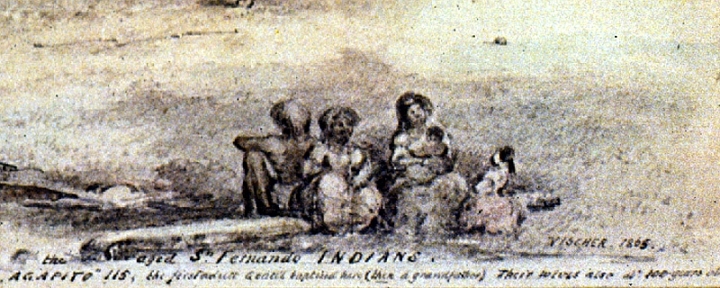|
|
Indians at Mission San Fernando
Drawing by Vischer, 1865
[FULL IMAGE][CLOSEUP LEFT-CENTER][CLOSEUP RIGHT]

Artwork by Vischer (1865) shows a mission scene with the following text:
Chapel and Principal Buildings of the Ex-Mission San Fernando.
Gen. D[on] Andres Pico, with his adoptive daughters, visiting the quarters of the ? aged San Fernando Indians.
The oldest surviving Mission Indians of California / Alifonso [age] 130 [illegible] / Agapito 115, the first [?] (? a grandfather) / Their wives are also ap[proximately] 100 years old.
Tataviam Indians from the Santa Clarita Valley, along with Kitanemuks of the Antelope Valley and Fernandeños and Gabrielinos of the San Fernando Valley were rounded up by Spanish missionaries and brought to Mission San Fernando Rey de España after its founding on Sept. 8, 1797. By 1803 most Tataviam villages in the Santa Clarita Valley were gone, although some Tataviam arrived at the mission as late as 1811. Indians were put to work on the mission lands (basically all lands were now mission lands), and members of the different tribes intermarried to the point where there were no full-blooded Tataviam Indians after 1921.
JJ1006c: 2400 dpi jpeg from 96 dpi jpeg
The site owner makes no assertions as to ownership of any original copyrights to digitized images. However, these images are intended for Personal or Research use only. Any other kind of use, including but not limited to commercial or scholarly publication in any medium or format, public exhibition, or use online or in a web site, may be subject to additional restrictions including but not limited to the copyrights held by parties other than the site owner. USERS ARE SOLELY RESPONSIBLE for determining the existence of such rights and for obtaining any permissions and/or paying associated fees necessary for the proposed use.